Subsidies’ Impacts on Technical–Economic Indicators in Large Crop Farms
Abstract
:1. Introduction
2. Materials and Methods
3. Results and Discussions
3.1. Analysis of the Technical Indicators for the Crop Farm of 3000 ha
3.2. Analysis of Technical Indicators for Crop Farm of 600 ha
3.3. Analysis of Income and Profitability for the Crop Farm of 3000 ha
3.4. Income and Profitability Analysis for Crop Farm of 600 ha
3.5. Presentation of the Statistical Model for the 3000 ha Crop Farm
4. Conclusions
- ▪
- Within the large crop farm of 3000 ha, the economic performance during the analyzed period was favorable, which has been determined to lead to a profitability of the activity. It is necessary to specify that in 2021, the best results were recorded, as follows: 15.52% economic return and 19.92% financial return. The production value of the crops included in the annual crop plan recorded significant fluctuations in the period 2019–2022. The maize culture stood out for the significant increase in production values in the 2020 and 2021 agricultural years, because it exceeded the national, regional and county averages. The results underline the fact that subsidies had a significant role in determining the gross product of each crop, and sometimes, these non-reimbursable incomes contributed overwhelmingly to the determination of a positive value for this area of net income achieved. The analysis of these three agricultural and financial years has highlighted the fact that the corn and soy crops were consistent in their achievement of farm income, for which the gross product and net income were high, despite the yearly fluctuations in average production. Although there are fluctuations in the production values of different crops, the net corn revenues continued to be high, and even increasing, recording an average of RON 3,182,893.05.
- ▪
- Within the large crop farm of 600 ha, the economic performance was fluctuating in the period 2019–2021, having the ability to generate constant profit. But it was found that in 2020, the results recorded placed the farm close to the profitability threshold. That year, the revenues from operating subsidies tipped the balance towards achieving positive financial results, highlighting their role in supporting agricultural activity. This farm had, in 2019 and 2021, good profitability from the economic and financial points of view. The year 2021 stood out, with a good return from the economic (65.36%), financial (50.81%) and employed-costs (53.76%) points of view. For this farm, the statistical model was inconclusive, because the culture plan is optimized annually, depending on agrometeorological predictions, the level of subsidies and market trends. The change of crops from one year to another precludes the estimation of the measure in which each crop could consistently contribute to maintaining the financial balance. Although the subsidies impacted the value of the net income, it was not possible to quantify their contribution.
Author Contributions
Funding
Institutional Review Board Statement
Data Availability Statement
Acknowledgments
Conflicts of Interest
References
- Anghelache, C. Structural Analysis of Romanian Agriculture. Rom. Stat. Rev. Suppl. Rom. Stat. Rev. 2018, 66, 11–18. [Google Scholar]
- Yang, T.; Chandio, A.A.; Zhang, A.; Liu, Y. Do Farm Subsidies Effectively Increase Grain Production? Evidence from Major Grain-Producing Regions of China. Foods 2023, 12, 1435. [Google Scholar] [CrossRef] [PubMed]
- Bai, J.; Wang, Y.; Sun, W. Exploring the role of agricultural subsidy policies for sustainable agriculture Based on Chinese agricultural big data. Sustain. Energy Technol. Assess. 2022, 53, 102473. [Google Scholar] [CrossRef]
- Bellmann, C. Subsidies and Sustainable Agriculture: Mapping the Policy Landscape; Hoffmann Center for Sutainable Resource Economy, Chatham House: London, UK, 2019. [Google Scholar]
- Madhur, G. Agricultural Subsidies: Resurging Interest in a Perennial Debate. Indian J. Agric. Econ. 2015, 70, 83–89. [Google Scholar]
- Xu, J.-F.; Liao, P. Crop Insurance, Premium Subsidy and Agricultural Output. J. Integr. Agric. 2014, 13, 2537–2545. [Google Scholar] [CrossRef]
- Meyer, R.L. Subsidies as an Instrument in Agriculture Finance: A Review; World Bank: Washington, DC, USA, 2011; Available online: https://hdl.handle.net/10986/12696 (accessed on 5 June 2023).
- Heyl, K.; Ekardt, F.; Sund, L.; Roos, P. Potentials and Limitations of Subsidies in Sustainability Governance: The Example of Agriculture. Sustainability 2022, 14, 15859. [Google Scholar]
- Edwards, C. Agricultural Subsidies. 16 April 2018. Available online: https://www.downsizinggovernment.org/agriculture/subsidies (accessed on 9 June 2023).
- Chengyu, S.; Yanru, L.; Wei, J. Effect of Insurance Subsidies on Agricultural Land-Use. Int. J. Environ. Res. Public 2023, 20, 1493. [Google Scholar]
- Poczta-Wajda, A. Assistance to Agriculture in Countries of a Different Development Level and Trends in World Trade with Agricultural Products. Polish Association of Agricultural Economists and Agribusiness-Stowarzyszenie Ekonomistow Rolnictwa e Agrobiznesu. 2014. Available online: https://ideas.repec.org/a/ags/paaero/206001.html (accessed on 15 May 2023).
- Garrone, M.; Emmers, D.; Olper, A.; Swinnen, J.F.M. Subsidies and Agricultural Productivity: CAP Payments and Labour Productivity (Convergence) in EU Agriculture. LICOS Discussion Paper. Katholieke Universiteit Leuven, LICOS Centre for Institutions and Economic Performance, Leuven. 2018. No. 409. Available online: https://www.econstor.eu/bitstream/10419/200493/1/1045706574.pdf (accessed on 15 May 2023).
- Kumbhakar, S.C.; Lien, G. Impact of Subsidies on Farm Productivity and Efficiency. In The Economic Impact of Public Support to Agriculture; Ball, V., Fanfani, R., Gutierrez, L., Eds.; Studies in Productivity and Efficiency; Springer: New York, NY, USA, 2010; Volume 7. [Google Scholar] [CrossRef]
- McCloud, N.; Kumbhakar, S. Do subsidies drive productivity? A cross-country analysis of Nordic dairy farms. Adv. Econom. 2008, 23, 245–274. [Google Scholar]
- Latruffe, L.; Bravo-Ureta, B.E.; Carpentier, A.; Desjeux, Y.; Moreira, V.H. Subsidies and Technical Efficiency in Agriculture: Evidence from European Dairy Farms. Am. J. Agric. Econ. 2017, 99, 783–799. [Google Scholar]
- Staniszewski, J.; Borychowski, M. The Impact of the Subsidies on Efficiency of Different Sized Farms. Case Study of the Common Agricultural Policy of the European Union. Agric. Econ. 2020, 66, 373–380. Available online: https://www.old-aj.cz/web/agricecon.htm?type=article&id=151_2020-AGRICECON (accessed on 10 May 2023). [CrossRef]
- National Institute of Statistics. Available online: https://insse.ro/cms/files/GAC/tabele/AUTOREP_7.HTM (accessed on 12 August 2023).
- Střeleček, F.; Zdeněk, R.; Lososová, J. Comparison of agricultural subsidies in the Czech Republic and in the selected states of the European Union. Agric. Econ. 2009, 55, 519–533. Available online: https://www.old-aj.cz/publicFiles/68_2009-AGRICECON.pdf (accessed on 20 May 2023).
- Rizov, M.; Pokrivcak, J.; Ciaian, P. CAP Subsidies and Productivity of the EU Farms. J. Agric. Econ. 2013, 64, 537–557. [Google Scholar]
- Garrone, M.; Emmers, D.; Lee, H.; Olper, A.; Swinnen, J. Subsidies and agricultural productivity in the EU. Agric. Econ. 2019, 50, 803–817. [Google Scholar]
- Czyzewski, B.; Smedzik-Ambrozy, K. The regional structure of the CAP subsidies and the factor productivity in agriculture in the EU 28. Agric. Econ. 2017, 63, 149–163. Available online: https://www.agriculturejournals.cz/pdfs/age/2017/04/01.pdf (accessed on 25 May 2023).
- Banga, R. Impact of Green Box Subsidies on Agricultural Productivity, Production and International Trade. International Trade Working Paper. Commonwealth Secretariat. 2016/13; pp. 5–24, ISSN 2413-3175. Available online: https://www.thecommonwealth-ilibrary.org/index.php/comsec/catalog/download/214/211/1532?inline=1 (accessed on 15 May 2023).
- Scown, M.W.; Brady, M.V.; Nicholas, K.A. Billions in Misspent EU Agricultural Subsidies Could Support the Sustainable Development Goals. One Earth 2020, 3, 237–250. [Google Scholar]
- Ursu, A.; Nicolescu, M.; Dinu, T.A. Practical Technical-Economic and Management Guide—Plant Production. Available online: https://dokumen.tips/documents/ghidul-vegetal-562a6953a44e4.html?page=1 (accessed on 28 May 2023).
- Stoicea, P.; Stoian, E.; Dinu, T.A.; Vlad, I.M. Appraisal analysis of an agricultural company and establishment of a development strategy. Scientific Papers Series Management. Econ. Eng. Agric. Rural. Dev. 2012, 12, 177–182, ISSN 2284-7995, e-ISSN 2285-3952. [Google Scholar]
- Dobre, I. Research on the Performance of Farms’ Management in French Agriculture. Calitatea 2013, 14, 338–343. Available online: https://www.proquest.com/openview/429205c4e3334e01fef1c80e10b92582/1?pq-origsite=gscholar&cbl=1046413 (accessed on 20 May 2023).
- Dumitru, E.A.; Stoica, D. Main sources of subsidy in Agriculture. In Agrarian Economy and Rural Development—Realities and Perspectives for Romania, 11th ed.; International Symposium; The Research Institute for Agricultural Economy and Rural Development (ICEADR): Bucharest, Romania, 2020; pp. 346–351. Available online: https://www.econstor.eu/bitstream/10419/234412/1/ICEADR-2020-p346.pdf (accessed on 27 May 2023).
- National Strategic Plan of Romania 2023–2027. Available online: https://apia.org.ro/wp-content/uploads/2023/01/Plan-National-Strategic-PAC-2023-2027_v1.2.pdf (accessed on 22 April 2023).
- Galluzzo, N. Analysis of subsidies allocated by the common agricultural policy and cropping specialization in Romanian farms using FADN dataset, Scientific Papers Series Management. Econ. Eng. Agric. Rural. Dev. 2016, 16, 157–164, ISSN 2284-7995, E-ISSN 2285-3952. [Google Scholar]
- Alexandri, C.; Pauna, B.; Saman, C. The Relationship between Total Factor Productivity and Subsidies in the Case of Romanian Farms. 2020, pp. 85–98. Available online: https://ipe.ro/rjef/rjef4_20/rjef4_2020p85-98.pdf (accessed on 18 May 2023).
- Alexandri, C.; Saman, C.; Pauna, B. Exploring the Relationship between Farm Productivity and the CAP Subsidies for the NMS. 2021, pp. 124–140. Available online: https://ipe.ro/rjef/rjef4_2021/rjef4_2021p124-140.pdf (accessed on 24 May 2023).
- Şurcǎ, D.E. Impact of subsidies in an agricultural exploitation of medium size from vegetable sector. In Agrarian Economy and Rural Development—Realities and Perspectives for Romania, 7th ed.; The International Symposium; The Research Institute for Agricultural Economy and Rural Development (ICEADR): Bucharest, Romania, 2016; pp. 126–132. Available online: https://www.econstor.eu/bitstream/10419/163363/1/ICEADR-2016_p126.pdf (accessed on 12 June 2023).
- Agresti, A. An Introduction to Categorical Data Analysis; John Wiley & Sons: Hoboken, NJ, USA, 2018; Available online: https://mregresion.files.wordpress.com/2012/08/agresti-introduction-to-categorical-data.pdf (accessed on 10 May 2023).
- Field, A. Discovering Statistics Using IBM SPSS Statistics; SAGE Publications: Thousand Oaks, CA, USA, 2017; Available online: https://uk.sagepub.com/en-gb/eur/discovering-statistics-using-ibm-spss-statistics/book257672 (accessed on 24 May 2023).
- Pallant, J. SPSS Survival Manual: A Step by Step Guide to Data Analysis Using IBM SPSS; Open University Press: Berkshire, UK; McGraw-Hill: New York, NY, USA, 2016. [Google Scholar]
- National Institute of Statistics. Plant Production for the Main Crops—Year 2021, 2022. Available online: https://insse.ro/cms/sites/default/files/field/publicatii/productia_vegetala_la_principalele_culturi_in_anul_2021_0.pdf (accessed on 16 May 2023).
- Ion, V.; Basa, A.G. Phytotechnics. Oleaginous Plants; Ex Terra Aurum Publishing House: Bucharest, Romania, 2021; pp. 208–350. [Google Scholar]
- Stoicea, P.; Basa, A.G.; Stoian, E.; Toma, E.; Micu, M.M.; Gidea, M.; Dobre, C.A.; Iorga, A.M.; Chiurciu, I.A. Crop Rotation Practiced by Romanian Crop Farms before the Introduction of the “Environmentally Beneficial Practices Applicable to Arable Land” Eco-Scheme. Agronomy 2023, 13, 2086. [Google Scholar] [CrossRef]
- National Institute of Statistics. Plant Production for the Main Crops—Year 2019, 2020. Available online: https://insse.ro/cms/sites/default/files/field/publicatii/productia_vegetala_la_principalele_culturi_in_anul_2019.pdf (accessed on 10 May 2023).
- Ursu, A. Economic efficiency analysis of vegetable production systems during 2011–2014. In Agrarian Economy and Rural Development—Realities and Perspectives for Romania, 5th ed.; The International Symposium; The Research Institute for Agricultural Economy and Rural Development (ICEADR): Bucharest, Romania, 2014; pp. 315–320. Available online: https://www.econstor.eu/dspace/bitstream/10419/111653/1/ICEADR-2014_p315.pdf (accessed on 24 May 2023).
- Cofas, E.; Ursu, A. The analyse of value structure of agricultural production for conventional agriculture. Scientific Papers Series Management. Econ. Eng. Agric. Rural. Dev. 2016, 16, 109–114. [Google Scholar]
- Stoicea, P.; Toma, E.; David, L.; Constantin, A.R.; Budileanu, A. Performance of large agricultural companies in Romanian agriculture. Scientific Papers Series Management. Econ. Eng. Agric. Rural. Dev. 2023, 23, 773–782. [Google Scholar]
- Stoicea, P.; Dinu, T.A.; Stoian, E.; Popescu, L. Evaluation of farm profitability by management intermediary balances. Scientific Papers Series Management. Econ. Eng. Agric. Rural. Dev. 2011, 11, 215–219. [Google Scholar]
- Toma, E.; Stoicea, P.; Dobre, C.; Iorga, A. The Effect of Eco-Scheme Support on Romanian Farms—A Gini Index Decomposition by Income Source at Farm Level. Agriculture 2023, 13, 1656. [Google Scholar] [CrossRef]

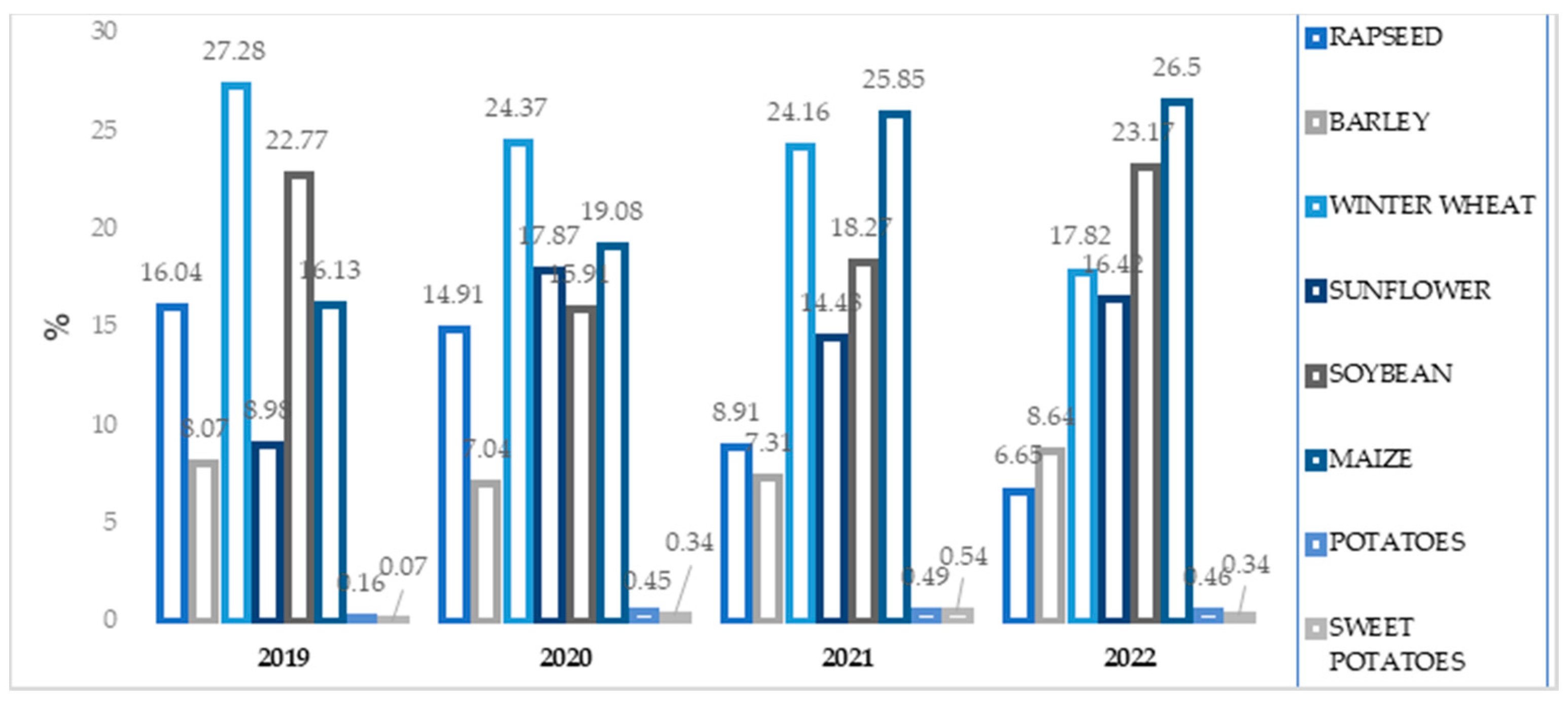


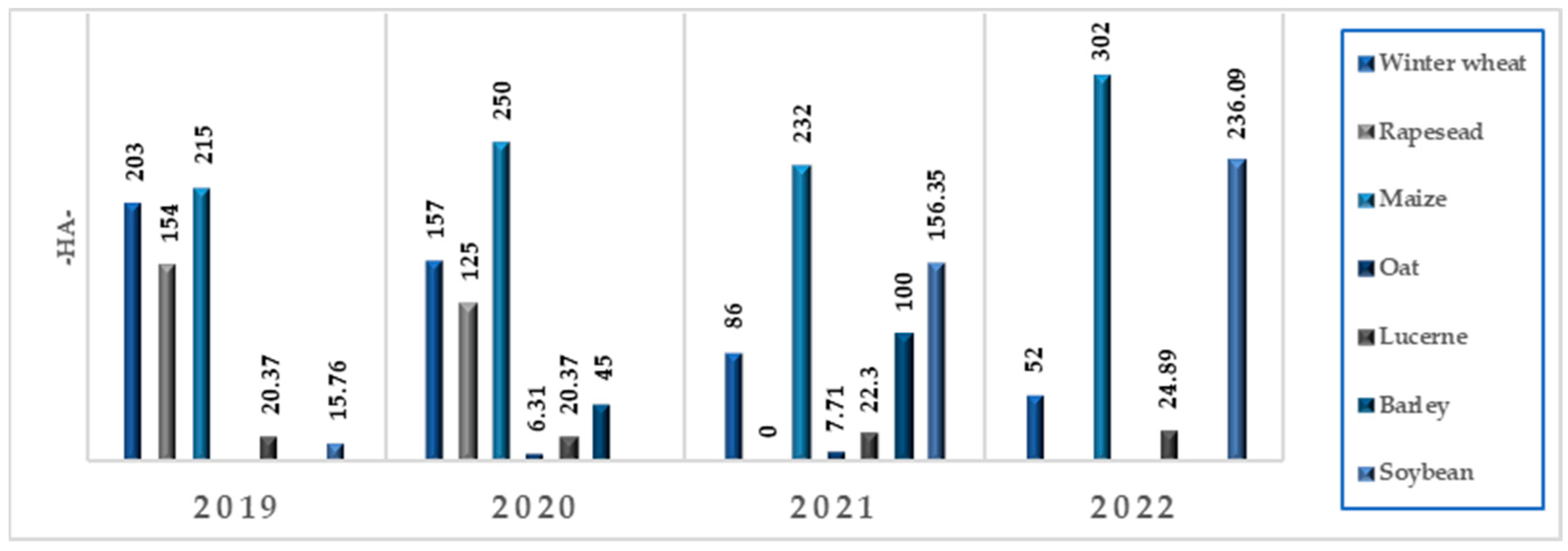


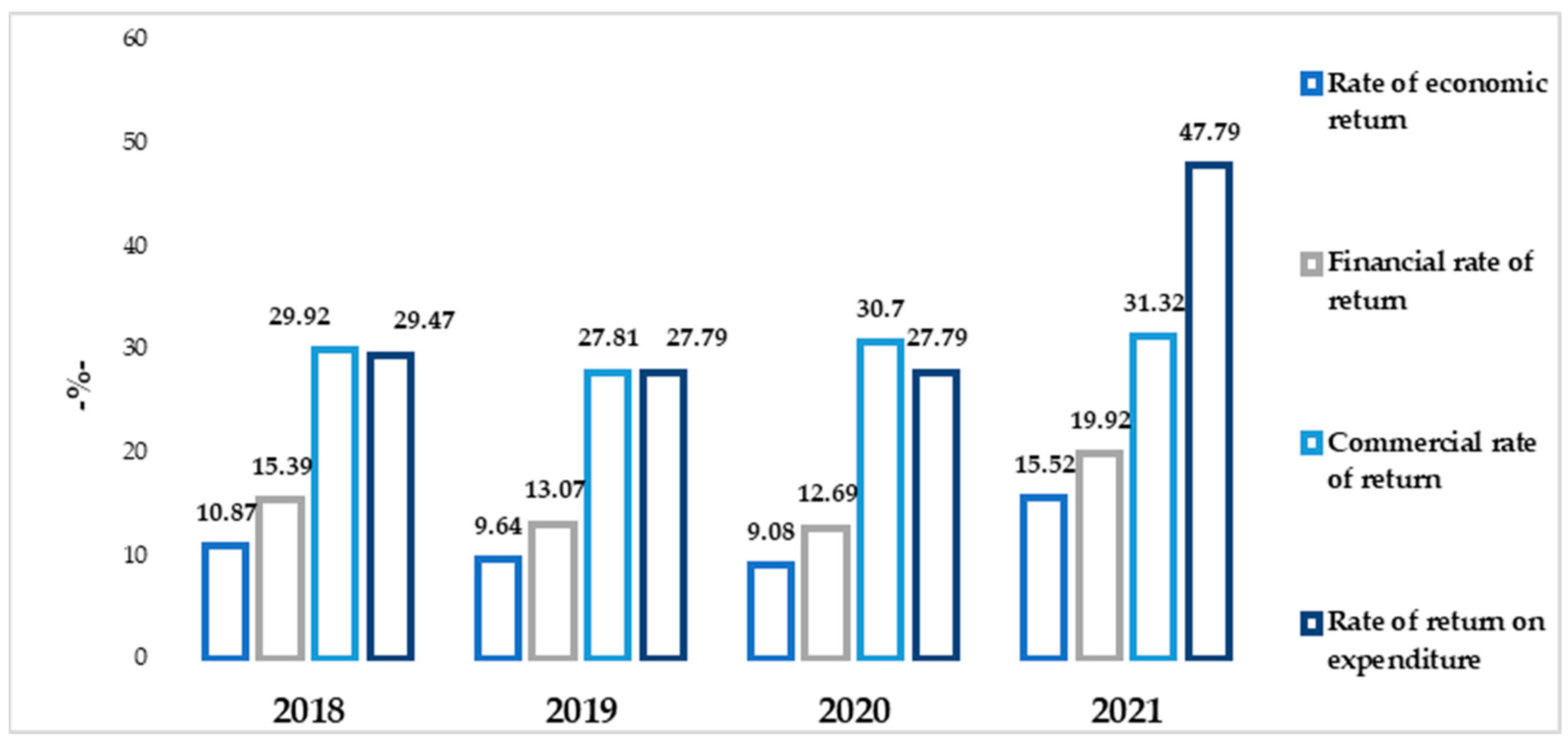

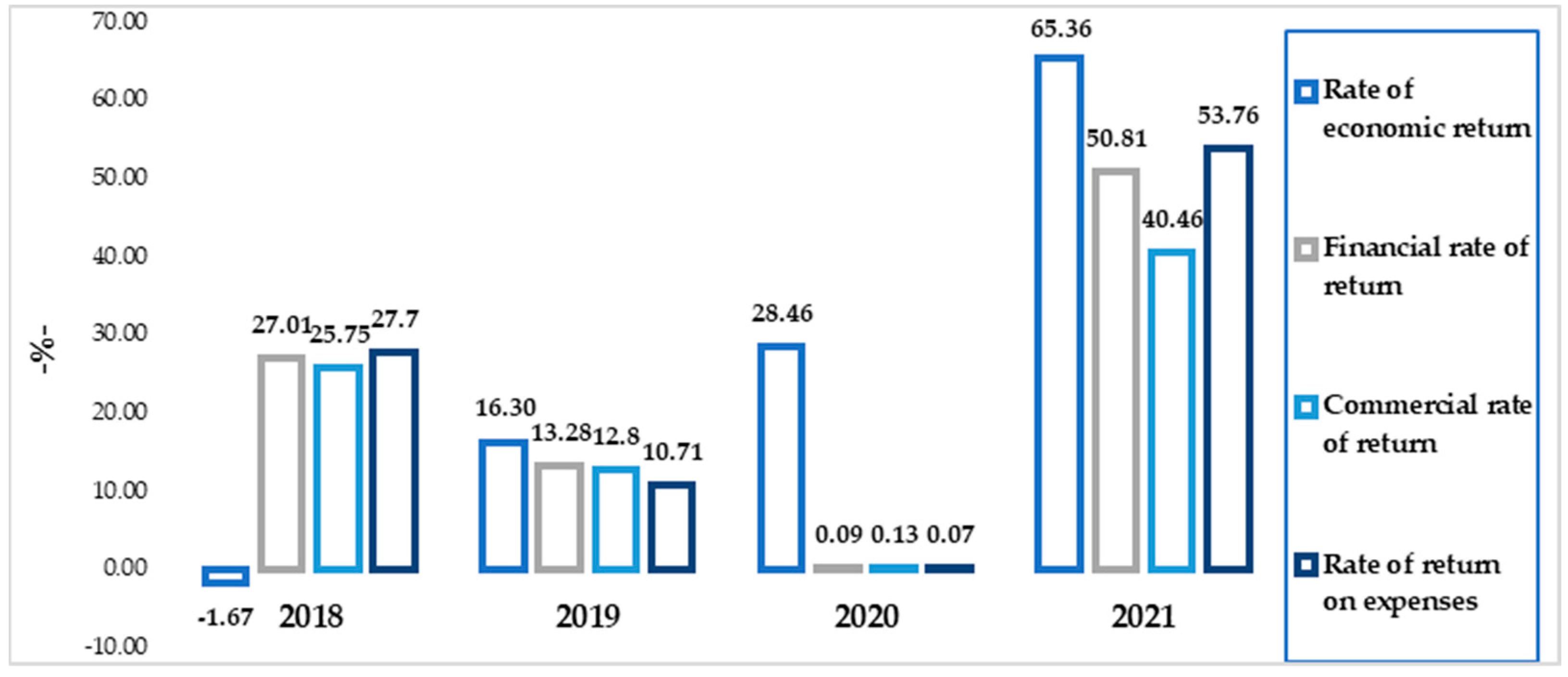
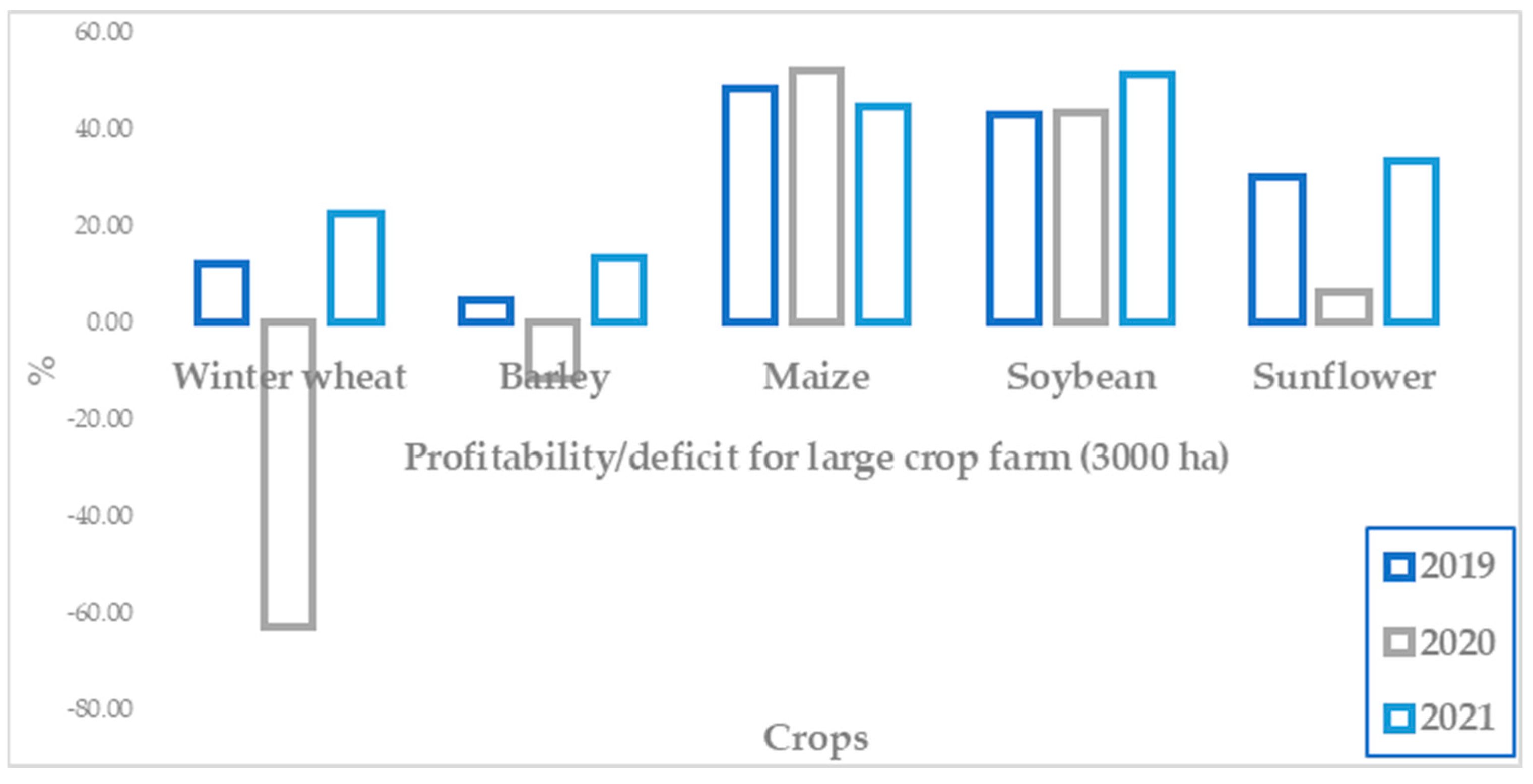

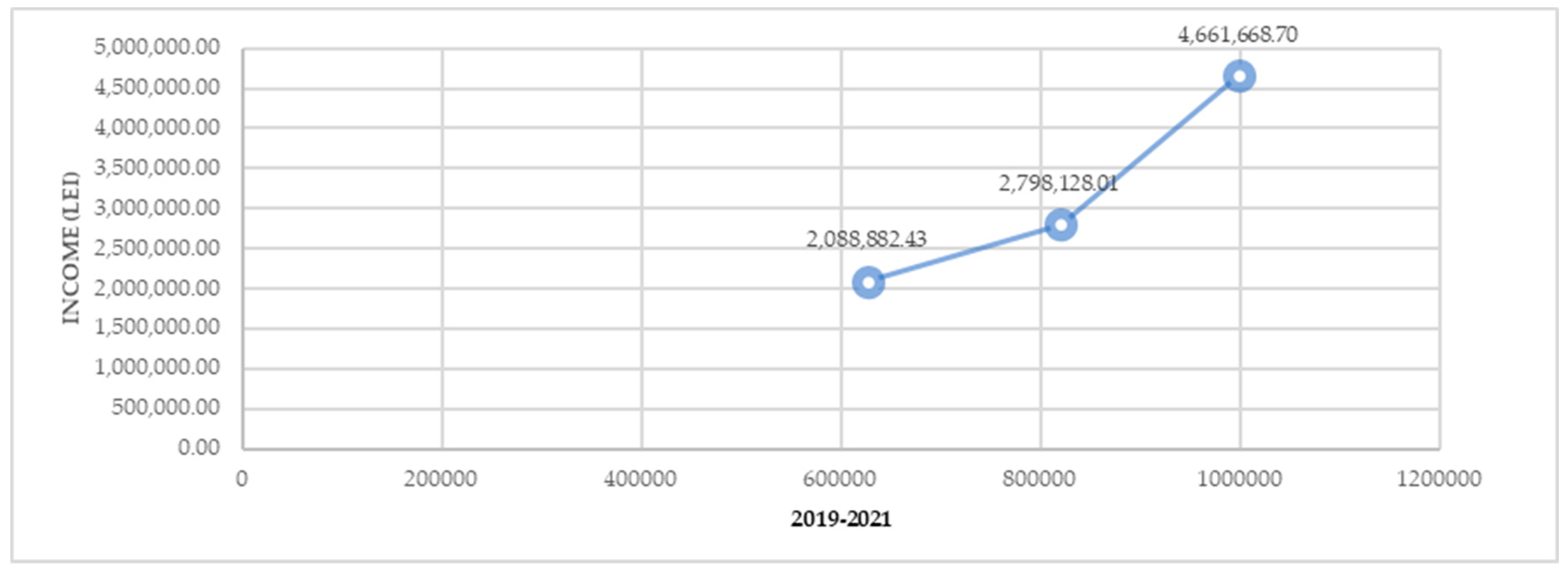
| Specify | N | Minimum | Maximum | Mean | Standard Deviation |
|---|---|---|---|---|---|
| -Lei (RON)- | |||||
| Production value of winter-wheat crop | 3 | 1,815,912.00 | 5,337,052.02 | 3,641,743.34 | 1,764,194.96 |
| Production value of barley crop | 3 | 763,114.56 | 1,440,811.32 | 1,075,598.16 | 341,911.581 |
| Production value of maize crop | 3 | 4,334,721.88 | 10,476,960.18 | 6,728,054.35 | 3,287,849.93 |
| Production value of soybean crop | 3 | 3,808,520.32 | 5,822,761.00 | 4,835,731.10 | 1,007,721.31 |
| Production value of sunflower crop | 3 | 1,442,178.00 | 3,159,554.56 | 2,303,467.85 | 858,700.10 |
| Valid N (listwise) | 3 | ||||
| Specify | N | Minimum | Maximum | Mean | Standard Deviation |
|---|---|---|---|---|---|
| -Lei (RON)- | |||||
| Amount of subsidies for winter-wheat crop | 3 | 933,404.20 | 1,047,361.87 | 1,008,970.66 | 65,445.29 |
| Amount of subsidies for barley crop | 3 | 282,525.70 | 309,637.22 | 298,238.25 | 14,061.07 |
| Amount of subsidies for maize crop | 3 | 627,514.75 | 998,474.95 | 815,266.05 | 185,521.81 |
| Amount of subsidies for soybean crop | 3 | 683,735.73 | 873,305.65 | 754,313.76 | 103,644.17 |
| Amount of subsidies for sunflower crop | 3 | 344,403.86 | 767,861.88 | 556,553.92 | 211,730.26 |
| Valid N (listwise) | 3 | ||||
| Specify | N | Minimum | Maximum | Mean | Standard Deviation |
|---|---|---|---|---|---|
| -Lei (RON)- | |||||
| Net income/deficit value of winter-wheat crop | 3 | −1,139,219.57 | 1,200,341.95 | 175,151.69 | 1,196,288.53 |
| Net income/deficit value of barley crop | 3 | −88,453.84 | 190,846.89 | 50,248.32 | 139,660.02 |
| Net income/deficit value of maize crop | 3 | 2,088,882.43 | 4,661,668.70 | 3,182,893.04 | 1,328,849.27 |
| Net income/deficit value of soybean crop | 3 | 1,652,523.38 | 2,982,916.09 | 2,243,242.55 | 677,588.91 |
| Net income/deficit value of sunflower crop | 3 | 151,261.82 | 1,050,025.49 | 544,577.82 | 459,754.46 |
| Valid N (listwise) | 3 | ||||
Disclaimer/Publisher’s Note: The statements, opinions and data contained in all publications are solely those of the individual author(s) and contributor(s) and not of MDPI and/or the editor(s). MDPI and/or the editor(s) disclaim responsibility for any injury to people or property resulting from any ideas, methods, instructions or products referred to in the content. |
© 2023 by the authors. Licensee MDPI, Basel, Switzerland. This article is an open access article distributed under the terms and conditions of the Creative Commons Attribution (CC BY) license (https://creativecommons.org/licenses/by/4.0/).
Share and Cite
Paula, S.; Constanța, T.V.; Elena, S.; Mihai, M.M.; Elena, S.; Ciprian, M.D. Subsidies’ Impacts on Technical–Economic Indicators in Large Crop Farms. Agriculture 2023, 13, 1712. https://doi.org/10.3390/agriculture13091712
Paula S, Constanța TV, Elena S, Mihai MM, Elena S, Ciprian MD. Subsidies’ Impacts on Technical–Economic Indicators in Large Crop Farms. Agriculture. 2023; 13(9):1712. https://doi.org/10.3390/agriculture13091712
Chicago/Turabian StylePaula, Stoicea, Tudor Valentina Constanța, Stoian Elena, Micu Marius Mihai, Soare Elena, and Militaru Dan Ciprian. 2023. "Subsidies’ Impacts on Technical–Economic Indicators in Large Crop Farms" Agriculture 13, no. 9: 1712. https://doi.org/10.3390/agriculture13091712
APA StylePaula, S., Constanța, T. V., Elena, S., Mihai, M. M., Elena, S., & Ciprian, M. D. (2023). Subsidies’ Impacts on Technical–Economic Indicators in Large Crop Farms. Agriculture, 13(9), 1712. https://doi.org/10.3390/agriculture13091712








